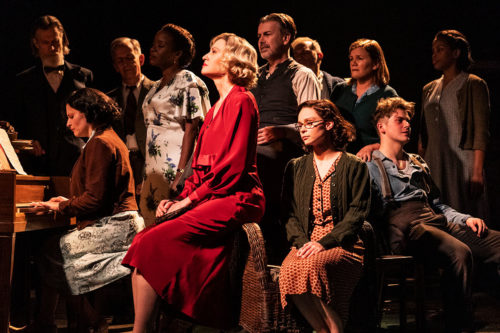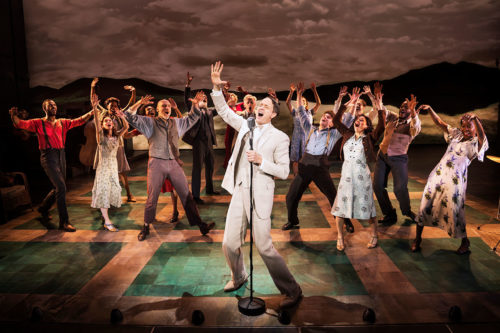Girl From the North Country: the Bob Dylan Jukebox Musical
In the Broadway musical Girl from the North Country, joy and sorrow are felt collectively, and they transcend temporal limits. Irish playwright and director Conor McPherson joins forces with composer Simon Hale, whose orchestrations for the musical were rewarded with a Tony Award in 2022. Set in Duluth, Minnesota in 1934, the play invites the audience to a musical journey that unveils the wretched destinies of individuals and families impacted by the Great Depression while they are temporarily floating at a guesthouse which is about to be foreclosed on.
 More than 20 of Bob Dylan’s narrative-driven folk compositions are interpreted by a multi-racial cast in a storyline that, among other social matters, hazily depicts the racial issues of the time. Set seven years before Bob Dylan was born in Duluth, the playwright builds a connection between Dylan’s songs and the world in the musical. Dylan lived in Duluth only until he was six years old and left Minnesota in his early twenties to relocate to New York City, but he kept recalling his home state and dedicating songs to it, including “Girl from the North Country,” from which the musical takes its name.
More than 20 of Bob Dylan’s narrative-driven folk compositions are interpreted by a multi-racial cast in a storyline that, among other social matters, hazily depicts the racial issues of the time. Set seven years before Bob Dylan was born in Duluth, the playwright builds a connection between Dylan’s songs and the world in the musical. Dylan lived in Duluth only until he was six years old and left Minnesota in his early twenties to relocate to New York City, but he kept recalling his home state and dedicating songs to it, including “Girl from the North Country,” from which the musical takes its name.
Resorting to Dylan’s music, which is written a few decades after the time-setting of this musical, reminds me of the time-consciousness philosophy of the German phenomenologist Edmund Husserl. It centers on the idea of an extended or ‘living’ present, which involves not only the momentary now, but it extends into the past and into the future. How often do we neglect to acknowledge the extension to which the fates of our predecessors determine our lives and how our decisions will condition the lives of those to come after?

In the play we’re introduced to characters who briefly meet and intertwine their fates at the guesthouse owned by the Laine’s. There’s the inept Nick who manages the guesthouse and his wife Elizabeth, who’s attached to her box of money and purse, and is said to suffer from mental illness, although what we witness is an individual with a strong ability to speak the truth when others withdraw from saying it out loud. Their son Gene, a wannabe writer who squanders his life by drinking and loses his beau, and their adopted daughter Marianne who is impregnated by a mysterious man-shaped creature visiting her room one night, resembling her suitor Mr. Perry – or at least that’s what she elucidates. Nick’s lover, Mrs. Nielsen, awaits her late husband’s shares on the railway construction to be able to run away with him. There’s also Dr. Walker who serves as the narrator of the plot as well as Elizabeth’s doctor, making sure she as well as other guests are equipped with their drug of choice. Then there are the temporary visitors: two runaways, Joe Scott who boxes for profit, Reverend Marlowe, a dubious cynical priest, Mr. Burke, an opportunist, his wife, and their slow son Elias. The singing and dancing parts are supported by other ensemble singers and dancers who don’t have an individual role.
What unites this vast batch of characters are poverty, lost opportunities, and hopes to capture momentary chances, as well as a fleeting desire to change their nemesis. The guesthouse is a filtering space for lost souls, a stepping stone either to the abyss or an unknown, potentially better future. It can also be read as a symbol of our temporary presence on this planet: entering, ideally leaving a mark, experiencing joy and sorrow, and leaving.
The dynamic between the songs that are sometimes referential (for example, “Sign on the Window” recalls Nick’s adultery) and reflect the atmosphere of the plot (“Like a Rolling Stone,” “Slow Train”), and the dialogue portions that aim to forward the story, remain dramaturgically loose and don’t allow for full character development or story arcs. Many of Dylan’s love songs (“Tight Connection to My Heart,” “Sweetheart Like You,” “Is Your Love in Vain?”) are utilized to contemplate the emotional state of the characters who seem rather devoid of being able to love, and are more focused on trying to survive. While the play attempts to present strong-willed female characters, it is very hard to empathize with any character really, as they remain unrounded.

On the other hand, the stage design by Rae Smith (also in charge of costume design) allows for the busy mise en scène to flow between the props, set drums and a piano, dance and choir scenes as well as to resemble the external setting of Duluth. The costumes capture both the style of the time as well as the social status of the characters: while Elizabeth is dressed girlishly, with her headscarf, purse, and box, denoting her readiness to move on, Marianne, Mrs. Nielsen and following ensemble singers wear light short-sleeved dresses, depicting the summer season. Mr. Perry and the Burkes, on the other hand, show off their full pockets through their elegance.
Most of the songs start as solos that are joined by a choir, which was quite enjoyable. Marianne (Sharaė Moultrie), Mrs. Nielsen (Carla Woods), and Gene (Ben Biggers), particularly stand out for the pleasant timbre of their voice. The dance scenes hold elements of swing, but often felt out of context with what we had just experienced in the dialogical part of the piece.
During summer 2023, I experienced the ensemble play Woody Guthrie’s American Song produced by the Mendocino Theatre Company. It is similar to Girl from the North Country, depicting the socio-political time period of the Great Depression, but is straightforwardly focused on the music and life of Woody Guthrie. I was touched to learn where his lyrics and sound were inspired, and satisfied to be presented with a simpler plot. Girl from the North Country aims to interweave a complex time-lapse of various layers, but leaves much to be desired in the untethering process.
- About the Author
- Latest Posts
Fjolla Hoxha is a writer, theater & drama critic, and performance maker from Prizren/Kosova, newly based in Nashville. Her artistic practice is rooted on assiduous research that grounds on critical theory, cultural studies, oral histories and narratives, institutional and personal archives. Aside from being a writer, Fjolla works as a cross-media performance artist, focused on site-specificity and audience participation. She has collaborated with various artists, collectives and institutions based in Europe and the U.S. and her work has been staged and stage-read in Kosova, Finland, Switzerland, Germany, UK while her plays and reviews have also been published in Greece and New York.



